What you’ll learn
“How does your son eat so well?” is the number one question we’re asked as parents, usually followed by “he has such a calm temperament.” We’re firm believers that eating habits and temperament are inextricably entwined, but that connection is too often overlooked.
This article is a brain dump on how we tackled baby eating through each phase, from milk to solid foods. Even though our sample set is N=1, the principles have held up well for us. Every child is different, but also not so different; I hope you find nuggets of wisdom for your family.

Motivation: good eating nets you more free time and energy
Eating is the bottom of the pyramid, the foundation, of life; it is life; the buck starts and stops here. Behavior, temperament, energy, and sleep all start with solid eating habits. We’re so adamant on this that we entertain beer-and-bourbon bets that you’ll see calmer, more even temperament and better sleeping with a solid eating foundation.
You have limited time and energy as a parent, and efficient allocation of that time and energy into the base of the pyramid will make everything else easier. When our kid is on an eating schedule, he’s even-tempered without hangry crashes. He’s halfway through the “terrible twos” with hardly a blip on the negative behavior scale. He slept for 8hrs a night by 6 months and 12hrs a night by 1yo. We didn’t hit a lottery 3 times; they’re interconnected. And we bank that extra time and energy for ourselves as parents.
Another beauty is that with daily work, the effort to keep up eating habits diminishes. It just becomes a daily routine. It’s compound interest on our banked time and energy.
The overarching goals
Before we get into the brain dump, our mission as parents is really simple and self-centered. All the decisions we made (which seem numerous when written out) flowed from these, which made our decisions mostly subconscious and second-nature.
Objectives
- Self-preservation: we have energy to be us, not sleep-deprived and ragged
- Personal time: we continue what we love, like climbing, video games, photography
Key Results
- We don’t spend time cooking different meals
- Our kid enjoys a wide variety of nutritious food
- Our kid doesn’t rely on snacks or get cranky from crashes
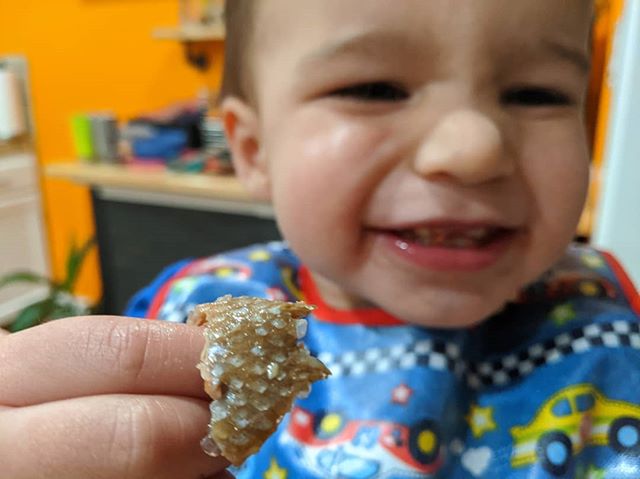

“But….” (rebuttals to the most common reactions we receive)
“You’re just lucky.” –I’m sure our kid is inclined to be food motivated, but it’s not an all-or-nothing genetic lottery. We consciously work daily on nutrition. And, he’s pretty “normal”: if we give him bread or if he sees kids with snacks, that’s all he’ll want.
“If only I could guarantee my baby would eat/sleep/behave well, I’d consider having kids.” –It’s not like you’re given a child with random behaviors that you can’t change. You nudge them down the path you want as a parent.
“My kid just doesn’t eat.” –They will when they don’t have food until the next meal, or the next meal.
“Just wait, things will change.” –Yes, things changed with our son every few months, but each time, we adapted. We know we’ll have to change our approaches as he evolves, but since our overarching goals are the same, we’re confident we’ll figure it out.
“I don’t have energy/time.” –See above “Motivation” section. Proper nutrition and eating habits are about the biggest bang-for-buck. It ends up being more like a daily nudge rather than a sledgehammer when you keep up good habits.
The milk period (birth to ~4mo)
From birth to 4-6mo, babies are on a milk-only diet. Pureed foods start around 4-6mo, at which point they’ll be on a hybrid milk-puree diet. This phase is much easier if you breastmilk-pump or formula-feed because you can measure exactly how much you kid is eating. See my other article on breastfeeding.
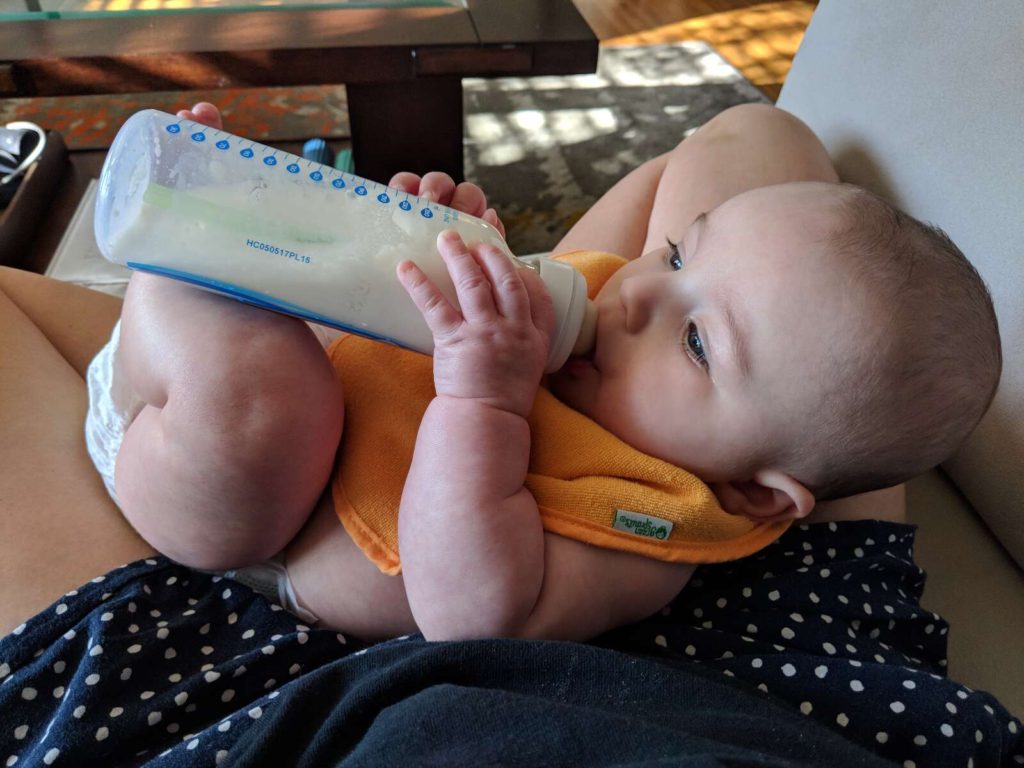

Use an app to keep a schedule. If you breastmilk-pump or formula-feed, dad can help. We used a shared app to log the time and how many ounces our son ate. When he screamed at 3am, I’d check the app for when dad last fed him, deciding if it was truly hunger or a cry-it-out situation. This avoided waking our baby to feed, when in fact he was just in a sleep cycle (imagine being forced awake and a nipple shoved in your face when you’re in the middle of a dream).
Google how big babies’ stomachs are. We knew exactly “how big are newborns’ stomachs,” e.g. 2oz at 2 weeks. Combined with tracking the schedule above, we had data to help us determine a feeding schedule, and when we could stretch out eating periods.
Google when growth spurts happen. We didn’t break feeding schedule unless we knew our son was in a known growth spurt, e.g. the big one at 6-8 weeks. Else, we didn’t break schedule more than 30min in 2hr feeding periods. It sets precedence for filling up when food’s available. This is best after 1mo when they’ve put on enough body fat.
Offer a “dream feed.” It takes weeks for a baby to get in the right day-night routine, but they will start sleeping for longer “nights.” We offered our son a last feed so he went to bed with a full stomach. This last feed became part of his feeding schedule, but we didn’t fret if he ate 1/4 or 1/2 or a full bottle.
Introduce “The Pause.” This is a general technique that works wonders on all facets of baby behavior. You acknowledge them, but wait a period of time before acting and offering anything. Starting from the delivery room, we paused for 10sec when our baby started crying. We literally verbally told our 12 hour-old baby “I hear you buddie, just a moment.” Babies cry. It sucks. But it’s often not for hunger. They’re tired, too cold, don’t like the feel of fabric, it’s too bright, they need to poop. Immediately offering food every time they’re uncomfortable sets a precedent for food being an answer to discomfort, rather than them figuring out how to self-soothe.
The soft foods period (4mo-1yr)
As soon as baby can sit up and keep their head up, you can give them tastes of pureed food. This is around 4-6mo. Depending on the kid, the food:milk ratio will increase up to 1yr, when it’ll be mostly food.

PRINCIPLE 1: START WITH PROTEIN AND VEGGIES, NOT CEREAL OR RICE
We were appalled to hear doctors recommend starting your child with cereal, rice, or refined carbs. Refined carbs have been stripped of natural fiber, vitamins, and minerals. They include cereals, most breads, pasta, and rice.
We wanted to kickstart our baby’s eating experience with unprocessed real foods with texture, flavor, and color, like avocado, spinach, broccoli, ground meat (pureed meat is actually close to milk protein content). Babies don’t need extra carbs from cereals or bread; an 8oz serving of whole milk has ~12g of carbs, and veggies have a fair amount of carbs (e.g. beets, squash, carrots).
Fruits are carbs. Fruit is better than refined carbs, since as long as they’re not processed and stripped like juice, they’re contained within fruit fiber and slower to digest. But, fructose is converted into glucose and glycogen, which increases triglycerides and ultimately has a similar effect as sucrose (common sugar). Also, fruits are much less nutrient-dense than veggies. A yellow bell pepper has 3.5x the Vitamin C as the same amount of an orange, with half the sugar. Fruits are essentially devoid of Vitamin B. And so forth.
We gave our baby fruits only after he ate a variety of veggies, and then low-sugar fruits like blueberries, raspberries, blackberries.
PRINCIPLE 2: KEEP SCHEDULE / NO SNACKS
By 6mo, babies’ liver and fat deposits should be mature enough so they can condense to <5 feedings a day. We were very particular to not stray more than 30min from schedule unless he was in a growth phase.
Our doctor told us to offer food between milk feedings, so to catch interest and hunger. This alarmed us–we worked so hard to decrease the number of feedings (thereby giving us time to ourselves), so why would we revert?
Anything that passes their mouth that’s not in the 1hr scheduled eating window is a snack. No snacks.
PRINCIPLE 3: INVOLVE THEM
We wanted to instill the importance of eating through family culture, so we put our baby in a bumbo chair on the table when we ate. Starting at 4mo, he saw us enjoy our food. We also talked animatedly about our food. I think even as a baby he picked up on those cues that eating’s fun, important, and a family thing. Have them sit with you when you eat, even if it’s not on their schedule. It’s no extra time out of your day to have them watch you eat.
PRINCIPLE 4: OFFER IT AGAIN
Our baby didn’t take to all foods immediately, even avocado. We didn’t make a big deal of it, but tried again and again and again. Acquired tastes take humans 8-10 times.

BONUS PRINCIPLES
Don’t offer the same food 3 days in a row. Doctors will tell you to introduce foods one a time for 3 days to rule out allergies. That’s BS and we learned the hard way. We started with avocado, spinach, beets. Imagine what your stomach would feel like and what your poop would be if you ate spinach 3 days in a row or beets 3 days in a row. There’s a very specific list of known allergens, and most veggies and meat aren’t on that list. We learned from error to mix things up.
Build a freezer full of frozen pureed food. I set aside 1 day every 2 weeks to steam, puree, and freeze foods, so that I had a stash of at least 10 food items that lasted at least 2 weeks. I used 3oz silicone ice cube trays and had about 15 ziploc baggies in the freezer. Every meal, it was a 2min operation to open the freezer and defrost an ice cube.
Add butter, oil, salt, pepper, garlic. Don’t be afraid to add any. Plain spinach is plain. You’ll need some form of butter or oil to puree most foods, anyways, and fat is necessary to absorb vitamins A, D, E, and K. And unless you’re feeding your kids supersaturated sodium canned soups, himalayan or sea salt is beneficial for trace minerals.
Eat only in the kitchen or designated area. If your baby is prone to putting anything in their mouth, this is a good safety backstop. In the milk phase, we fed our baby on the couch, but once we moved to pureed foods, we fed him only in the kitchen. We did this for practical reasons, but in hindsight, it created a division of edible things vs. other things.
No toys shaped like food. Combined with the previous point, it creates a divide between ok-to-ingest and not-ok-to-ingest items. It’s a safety constraint, at least until they’ve passed the mouthing phase.
Introduce allergens in the 6-9month open window. We now know that there’s a window between 6-9mo that closes where introducing known allergens will prevent food allergies in life. Early indications show a 10x reduction in peanut allergies and 4x reduction in egg allergies when inside this window. Babies’ stomach bacteria are developed enough to process food and are in a developmental stage to set the right microbiome. That window closes, and waiting until 1yr+ leads to more allergies.
Horseradish, lemon, mustard, wowee. We gave our baby finger-licks of our food starting at 4mo. Many babies actually like nasally foods like horseradish and mustard, or tart lemon. Our son loved seeing us eat and then licking anything with flavor, like BBQ sauce and Worcestershire sauce. We gave him licks with exaggerated smiles and delight. Today, our son is a “dip dip” aficionado, asking for “bibimic dip dip” (balsamic), “yellow dip dip” (turmeric ginger), and “wivmeowcxv” (Worcestershire sauce) at 2.5yo.
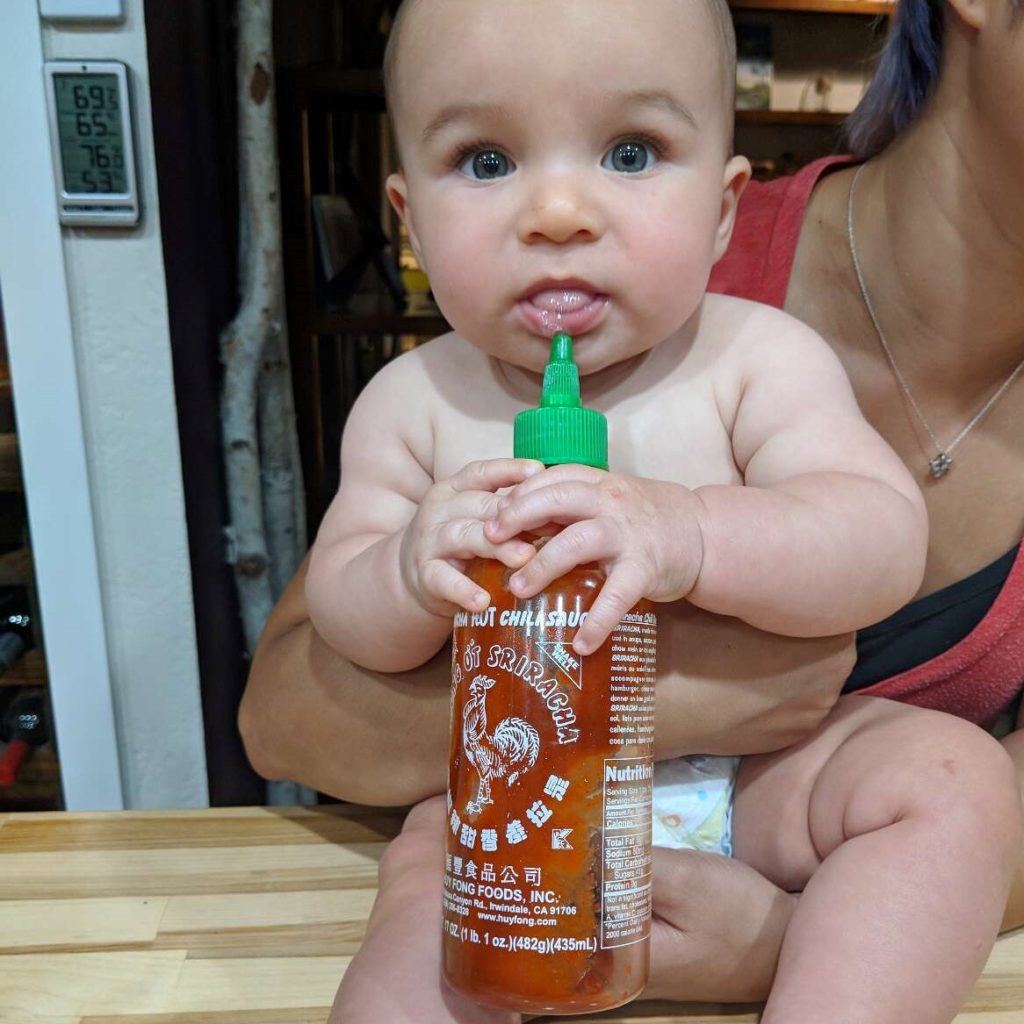
Solid foods (1yr+)
Your child will be ready for solid foods when they have some teeth. This varies greatly, but can be as early as 1yr. Foods like over-cooked asparagus or broccoli leaves can be introduced even earlier. At this point, they’re old enough to be part of the family eating routine, with breakfast, lunch, afternoon “snack,” and dinner.
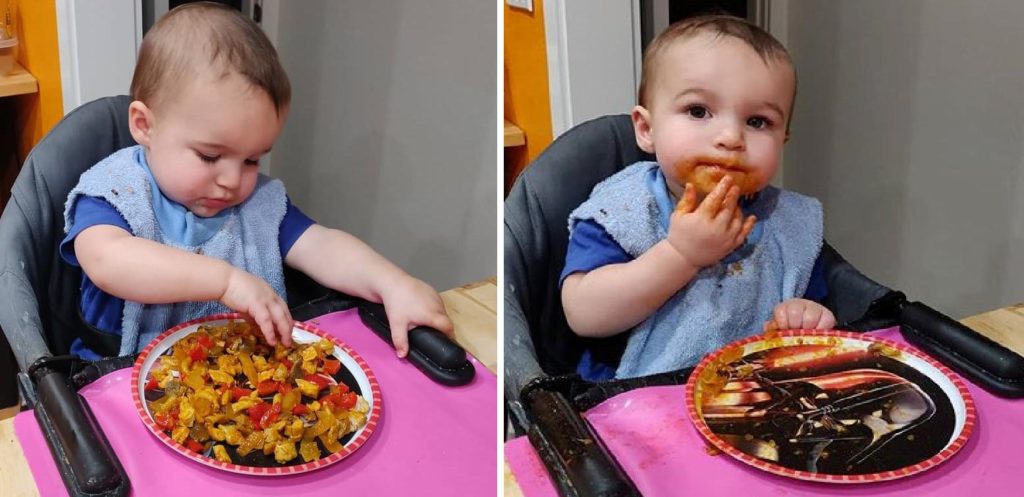
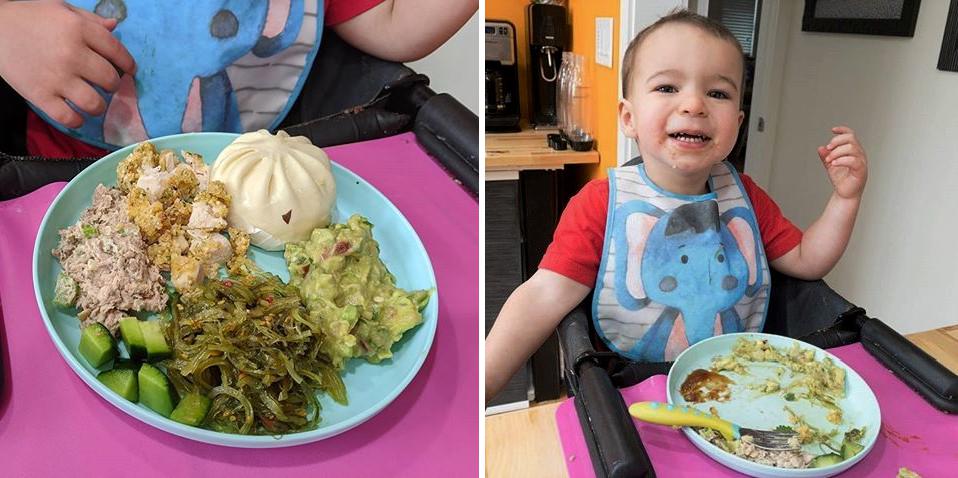
PRINCIPLE 1: NO PROCESSED CARBS
As compared to the typical American diet, we’re “low carb,” but not keto. The standard American diet is 200-300g carbs/day (that’s even following the recommended food pyramid); typical keto diets are <20g carbs/day; we average 60g +/- 20g net carbs/day. We feed our child scaled portions of what we eat, mostly from a ton of veggies, sometimes beans and lentils, and dairy like plain whole milk yogurt.
Natural sources of carbs include carrots, squash, beets, broccoli, nuts and seeds. We’ll also eat beans, lentils, quinoa, but in modest amounts (I’m guessing 1/4 – 1/2 cup at a time). We limit refined, simple carbs like pastas, rice and bread (when we do it’s sprouted grain or fermented sourdough) to maybe once per week. We don’t buy bagged snacks–we have no need to–so nothing like freeze-dried fruit, granola bars, crackers, cookies, chips, or Goldfish crackers. If it comes in a box with more than 3 ingredients and is shelf-stable for months, it’s probably processed.
Glycemic index (GI) is a measure of how fast 50g of carbs in a particular food affect blood glucose levels. Relative to 100 (pure glucose), a higher number means more fast-hitting insulin spikes. Time and time again, we see that keeping low and level is best with our kid, else he’s hyper, hangry, then crashes. The GI of common foods:
- White potato: 83
- Instant oatmeal: 79 (rolled oats: 55)
- Bread, rice: 70
- Pasta: 60
- Milk chocolate: 50
- Apple, peach: 40
- Carrots, beans: ~35
- Blackberries, lentils: ~25
- Plain greek yogurt, bell pepper, walnuts, avocado, cucumber: 15
- Meat: none
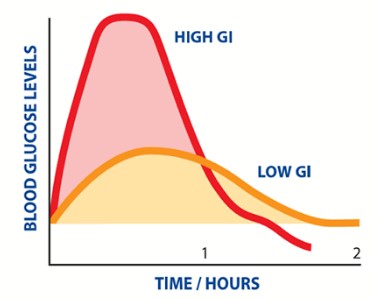
Sugar is sugar, even if it’s organic, including freeze-dried organic fruit packs, applesauce packets, and flavored yogurt squeeze tubes. Compared to the amount of sugar in a regular size Hershey’s bar, a banana has 50% less, a cup of applesauce is the same, a 1.2oz bag of freeze-dried blueberries is 50% more. We still eat natural foods like fruits, but we treat it as something special rather than the norm.
I highly recommend tracking anything that passes your mouth using an app like Cronometer for 2 weeks. It’ll be really enlightening. A cup of oatmeal or 2 slices of bread is 35g carbs; 1cup of whole wheat pasta is >40g. That alone is >100g of carbs a day, before milk, fruit, snacks, etc. It’s no wonder kids live on such ups and downs, having trouble concentrating and sleeping.
PRINCIPLE 2: KEEP SCHEDULE / NO SNACKS
NO SNACKS. Anything that passes their mouth that’s not in the 1hr scheduled eating window is a snack. We’re extremely adamant on this one. There are exceptions; those exceptions are very limited and very defined, e.g. traveling, picnicking, visiting friends and grandparents. The key is those are defined events that happen outside of the known routine of eating at the home kitchen table. After that, it’s back to the schedule. Our son doesn’t have crackers, chips, fruit, or anything on demand. We’ve never owned snack containers (gasp). [Note that most kids won’t be able to go from lunch until dinner without an afternoon “snack,” like at 4pm. I don’t count that as a real snack since it’s built into the feeding schedule, is defined, constant, and happens at the kitchen table.]
No appetizers. We don’t give our son bread or crackers or anything before a meal. If he gets cranky, we sit him in the kitchen with us and talk to him about how we were cooking, stirring, preparing a plate, cooling it off, etc.
PRINCIPLE 3: INVOLVE THEM
Eating is family culture. Our son eats with us every time it’s possible. He sees us enjoy our food, and that we also conform to the standards we set for him. Starting from when our son was a few months old, we talked to him, making funny faces and noises, and describing food texture and colors. “Mmm, yummy carrots are orange,” “smooth avocado,” “wheee lemon juice.” On the flip side, we never say “eew stinky/slimy xyz.”
When he was about 1.5yo, we started having him watch us prepare food. It doesn’t have to be an extravagant meal, and you’re doing the work to cook anyways. It teaches them the effort and importance that goes into eating. At 2yo, our son started saying “thank you momma/dada cooking” before each meal.
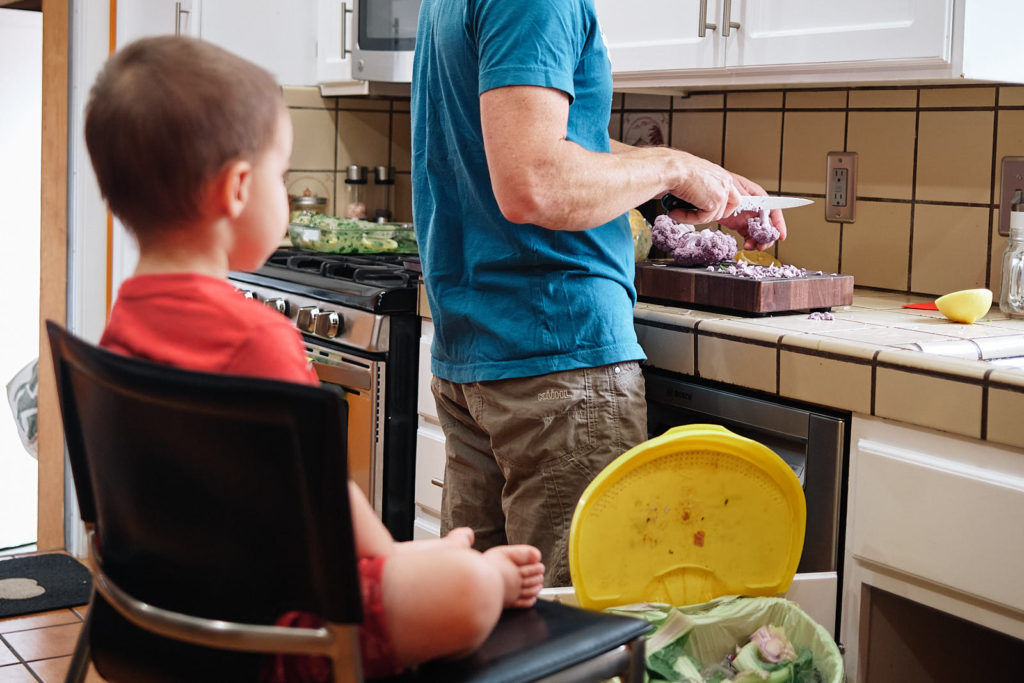
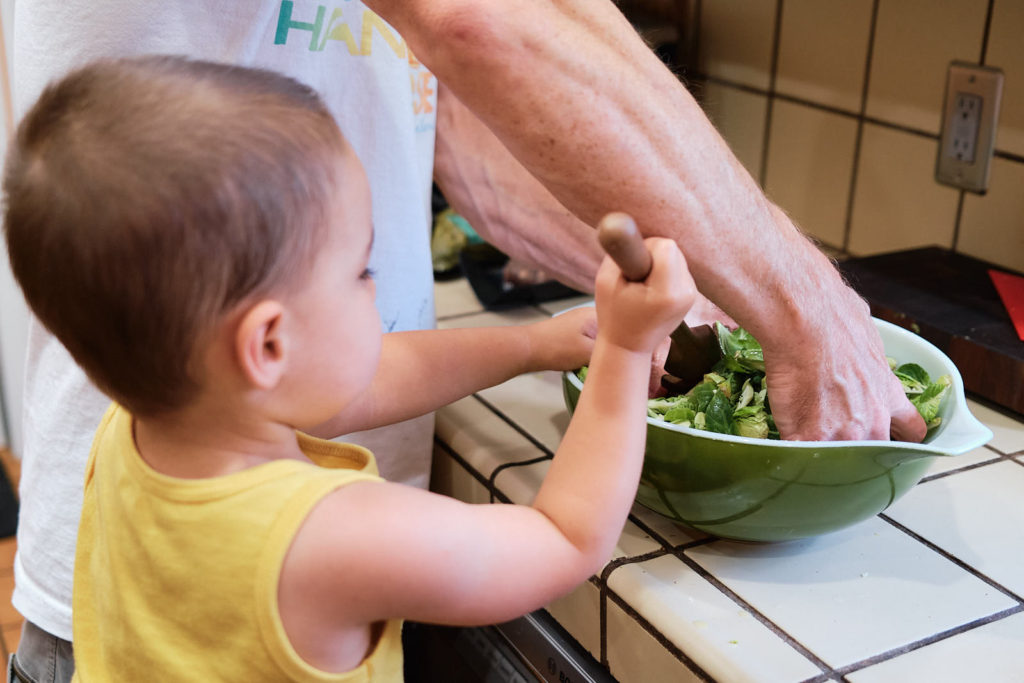
PRINCIPLE 4: NO SUBSTITUTIONS
Eat what you’re given or don’t eat. They’re not going to like some foods. But, for us, we weren’t going to stop eating what we love, and we weren’t going to cook separate meals, so we just kept offering foods when we cooked them. He sometimes went hungry, then most of the time acquired the taste. In the worst case, what’s life without a story about how your mom/dad cooked something you despised as a kid?
PRINCIPLE 5: REFILLS / SECONDS
Only 1 serving of milk at meals. Our son gets 1 cup of milk a meal, and if that’s gone, he gets water refills. We’ve seen friends’ kids get 3 refills of milk when they don’t like their meal, don’t eat their food, and don’t have a taste for food. When our son sees kids get more milk, of course he asks for more milk–he’s a normal child and we work to curb that behavior. He has tears when he doesn’t get what he wants, but he knows our hard line, gets over it in under 30sec, and eats.
No second helpings or topping off, even if it’s broccoli. Our son gets second helpings only when he’s finished his plate, or when he’s given an honest good attempt at eating everything. If the meal is chicken and broccoli, and he finishes his broccoli and asks for more, he needs to eat chicken first. This rule serves 2 purposes. (1) Our son is learning respect for food and consciousness of others. Remember the rule that no one gets seconds until everyone has firsts? (2) He’s learning what a balanced meal is, assuming we’ve put balanced portion sizes on his plate to begin with. Also, kids will ask for more things like broccoli and ketchup when they still have that thing on their plate–it’s a game, and it’s a no until he finishes what’s there.
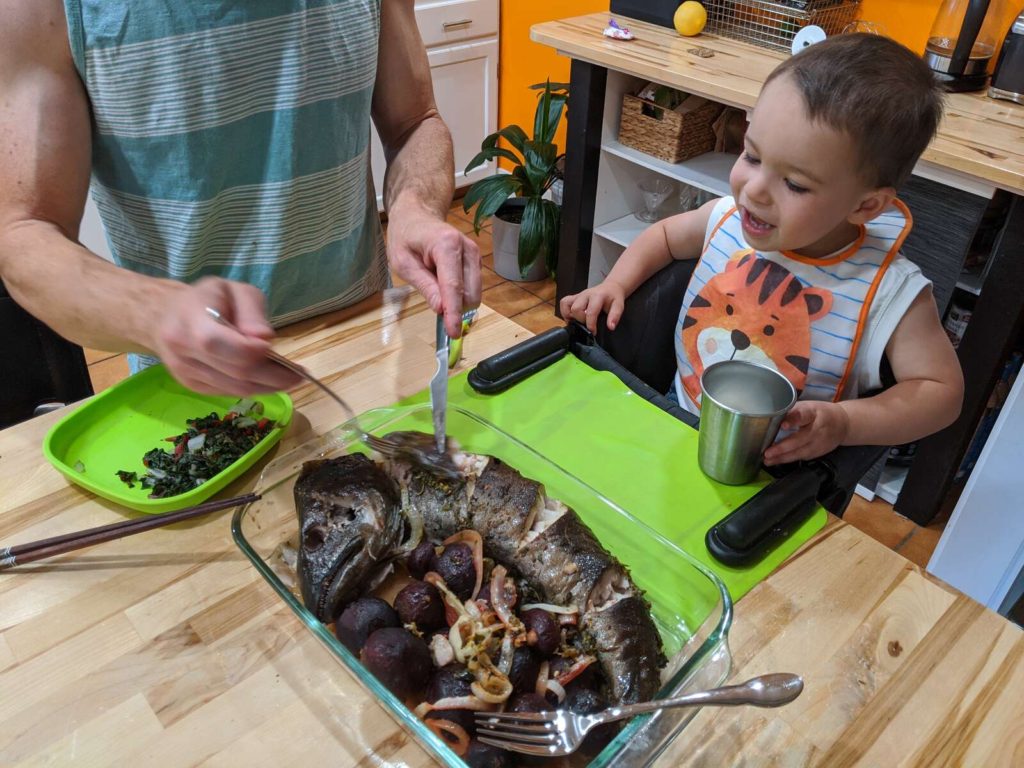
BONUS PRINCIPLES
Eat carbs late in the day. When you wake up, your cortisol levels are highest: it’s your natural fight-or-flight response to start the day. Cortisol releases glucose from the liver into blood, whereas insulin removes glucose from the blood. Eating pancakes, oatmeal, and hashbrowns is the worst at breakfast, since your body will need to produce relatively more insulin to offset cortisol. Try breakfasts of eggs and kale or yogurt with nuts and berries, and save the carbs for lunch or dinner. We notice a difference in even temperament in our son and ourselves.
Eat healthy fats, not seed oils. The human metabolism needs healthy fats like full fat milk, yogurt, nuts/nut butter, coconut oil, avocado oil, olive oil (no seed/vegetable oils like canola, safflower, sunflower, soy). Making sure your kid gets enough healthy fats means they’ll have energy to last until the next meal.
Let them play with their food within bounds. Babies are curious and want to squeeze and touch everything. We let our son explore food within bounds, like squeeze your food if it stays on your plate. To this day we verbally say “food stays on your plate or in your mouth.” It was probably around 1.5yo that he understood cause-effect and we give him max 2 warnings if food hits the ground on purpose, then he goes in his crib and doesn’t get the rest of his meal.
Utensils are utensils, not toys. That kid that’s throwing utensils at the restaurant? We have a no-tolerance policy. Utensils are reserved for a purpose; they’re a tool, not a toy. We bring other forms of entertainment when we go out. Likewise, toothbrushes are for teeth. Hammers are for wood.
Make exceptions special!
Of course we have exceptions, and everything we’ve done makes those special times truly special. Our kid will treasure the cobbler his favorite aunt makes, or shave ice or ice cream with his grandparents, or the surprise afternoon snack with mom in the backyard. Those are the wonders of life we want him to remember, not him having a relationship with sugar that’s a fueled by crankiness and need to survive to the next meal.
So, what do we feed our kid for special snacks? We give him dried seaweed, cashews, brazil nuts, these apricot-coconut-date squares (1oz, 6g sugar) from Trader Joe’s, lychee, figs, whatever’s in season.
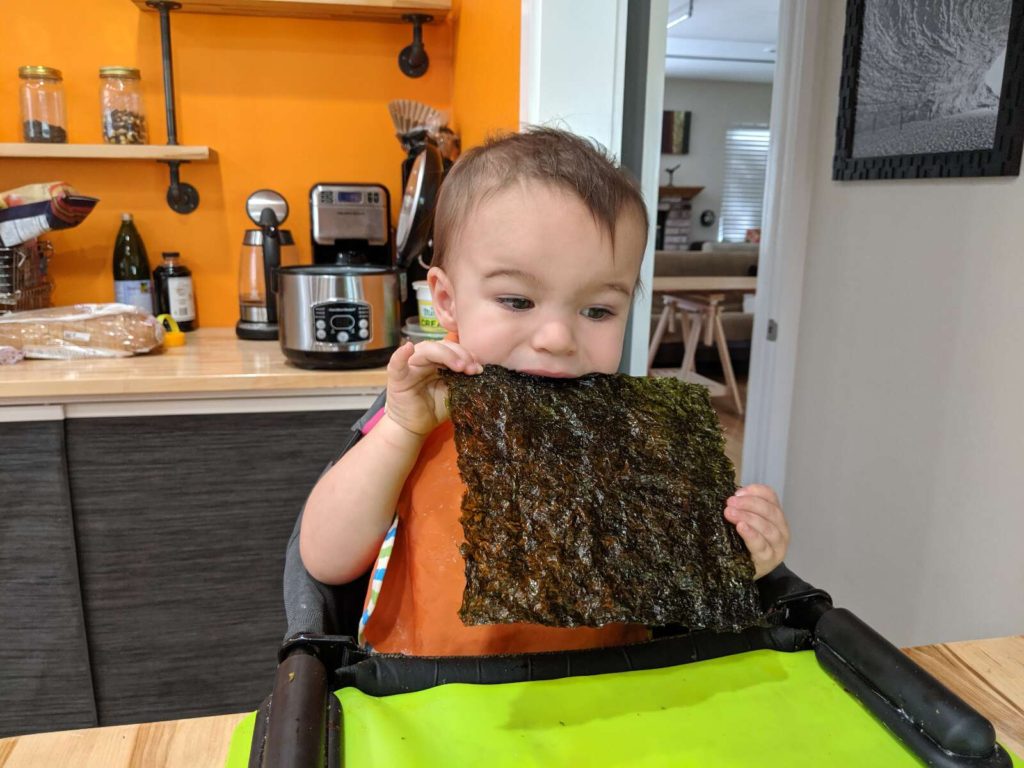
It’s freedom, not fascism
No, our house isn’t an oppressive dictatorship with eating. Instead, the framework has made our house flow smoothly. We optimize parental time by having set mealtimes and one meal plan to cook. We connect as a family to enjoy healthy food. Our kid is happier not being cranky from crashes between meals. We concentrate our energy on cooking 3 meals a day, rather than on whether we have snacks on hand and put that would-be snack money into meals. Also, kids gain freedom and independence by having boundaries–it creates space for freedom.
When things don’t go as planned
Things don’t always go smoothly, and we certainly learned a few of these rules by accident. Getting off-schedule typically happens (1) after a trip, like for a weekend or vacation, (2) after being around other kids or other kids’ parents, (3) he just doesn’t want to eat.
In all cases, we’ve noticed it takes about the same number of days to get him back on routine. We have a hard line of absolutely no food or snacks until within 30min of the next scheduled eating period. The short-term downside is that our life sucks until the next meal with a cranky, crying kid. But we get there, and our son knows what’s available and when.
There’s also days-long stretches when our son won’t eat much more than 1/4th his plate. We don’t make a big deal about it, and he’s usually fine until the next meal–he self-regulates. We’re taking that as a sign of a healthy metabolism that’s not dependent on snacks. Sometimes he’s a voracious eater days in a row and we chalk it up to growth spurts.
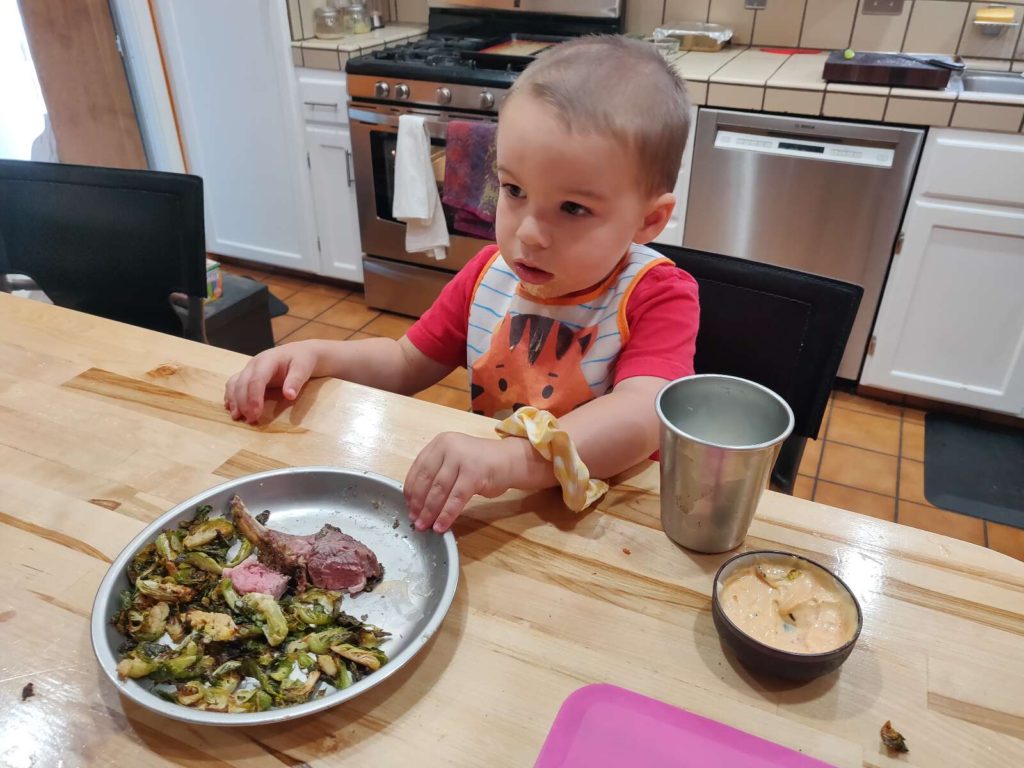
Just keep a single goal in mind
Now that I’ve written out everything we’ve done, it seems more prescient than it was. We are literally driven by a strong desire for self-preservation and selfishness for personal time.
Our elbow grease is doing research, questioning everything we’re told (since eating issues are the new norm, we figured conventional wisdom is wrong somewhere), watching others’ parenting styles (noting great ideas or terrible habits), being incredibly self-aware of our actions, pausing for a split second before acting to think “is this going to make my life worse in the long run?” and being in-sync with each other for consistency.
Do your own research! Question conventional doctors and passed-down wisdom. Make your own decisions for your family. Be selfish.
→ Explore more articles in Pregnancy & Kids